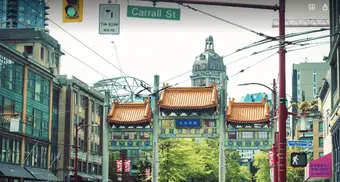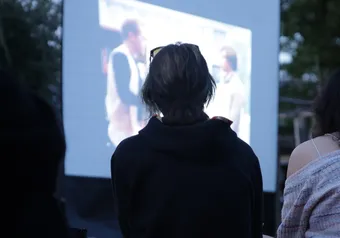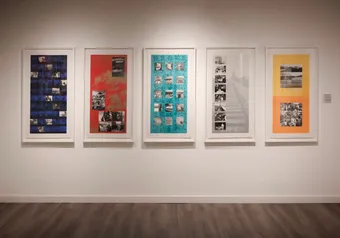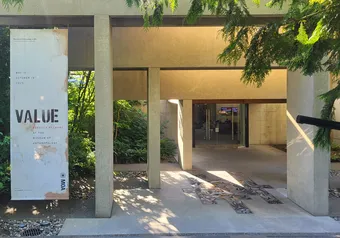Though Vancouver carries the weight of more than a century of development, the history and planning policies that have made its individual neighbourhoods what they are today are rarely obvious at first glance. This is doubly true of Vancouver’s Downtown Eastside and Chinatown, where community history and official policy have often been at odds.
CAPACity, UBC’s urban studies student club, arranged a walking tour on June 5 titled “The Changing Chinatown.” It aimed to raise awareness of how both neighbourhoods have developed, as well as the issues both urban planning-related and otherwise they currently face.
Daphne Stams, fourth-year geography major and CAPACity club president, described the club as a space to spark interest in the planning processes which shape the cities around us, as there are few urban planning courses at the undergraduate level.
This learning, however, is only possible if members of urban communities choose to share their knowledge. For the section of the walking tour focused on the Downtown Eastside, Herb Varley — a Nisga’a and Nuu-chah-nulth activist, and longtime resident of the neighbourhood— collaborated with CAPACity to take on that educational role.
His first note was simple and necessary: this event’s purpose isn’t tourism. Overpoliced and undersupported, the area and its residents are sensitized to passing groups staring, and researchers and journalists exploiting their stories and images for shock value. Varley and CAPACity instead aimed to promote a nuanced analysis of the top-down urban policies that has let the neighborhood down.
The Downtown Eastside’s story, Varley explained, begins with logging: its derogatory nickname, ‘skid row,’ referred originally to the skid road that once carried logs straight through it. Many of the hotel rooms that housed loggers on breaks from the camps still exist as single-room occupancy housing, converting quarters never originally meant for permanent stays into some of the only housing in Vancouver that can be paid for by a welfare cheque — though many of them are so flammable that cooking inside is forbidden.
Varley laid out one of the central dilemmas facing the area: the limited affordable indoor housing options are often unsafe or undesirable to occupants, but hostile architecture impedes people from sleeping on the street.
The single-room occupancies are in dire need of safety upgrades, but redevelopment introduces new risks: gentrification. Even new buildings pitched as affordable compared to Vancouver’s average housing prices are significantly more expensive than the SROs they replace. As a result, long-term residents unable to afford the higher rent are priced out.
To prevent housing prices in the area from rising, a necessary policy step is to clearly define “affordable housing.” This is one of the sticking points for Varley: even when pressed to provide a concrete definition, “the city wouldn’t do it.”
Varley pointed to a new development in the Eastside’s Woodward’s building, where upscale towers and freshly-opened banks face away from the Eastside and towards Gastown. The section fronting onto the Eastside is instead dominated by fast food outlets.
The two entrances and the stores surrounding them, Varley said, functionally segregate the development into two halves, preventing customers entering from Gastown from having to think about where it’s built. Varley noted that the development has raised the value of the blocks surrounding it all the same, rendering them inaccessible for the area’s residents.
Chinatown, which is located next to the Downtown Eastside, faces similar issues with gentrification and unwanted development. Beverly Ho, a Chinatown resident deeply connected to the neighbourhood’s culture, laid them out during the event.
Chinatown’s origins date from before Vancouver itself was incorporated as a town; Chinese immigrants banded together to create a familiar community as they sought work on the railroads and elsewhere, and community support became even more valuable in the face of the imposition of the head tax in 1885. Though often faced with hostile zoning, its unique culture has survived intact.
One of Chinatown’s most distinctive aspects is the Benevolent Associations: beginning as housing initiatives for the immigrants who originally formed the community, they now act as general community hubs, organized by family name. The difficulty of securing housing in Vancouver has led many seniors to fall back on the associations’ original purpose. Ho pointed out the two Benevolent Associations she belongs to, but every Chinatown block contains a handful of them.
Though the Benevolent Associations continue to provide housing support, the community has found success opposing gentrifying housing developments. 105 Keefer Street, once designated for development as a market housing tower, had its proposal rejected by the city’s chief planner in 2017. The decision came after sustained activism from local groups such as the Chinatown Action Group opposing the development. In its place, Ho said that Chinatown community organizers are pushing for the construction of a community centre and low-income housing.
Chinatown has a long history of successful confrontations with Vancouver’s zoning and land use decisions; Hu cited the Jack Chow insurance building, built on a six-foot-wide piece of land left after the city expropriated twenty-four feet for road widening.
When discussing her own involvement with the organizations that support Chinatown and its housing needs, Ho remained optimistic about the neighbourhood’s future: “we hope that we can work ourselves out of a job.”
First online
Share this article








